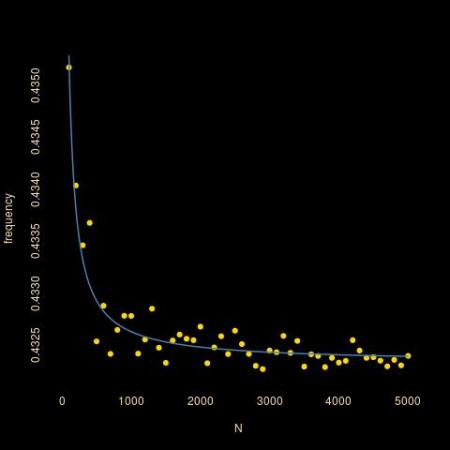gap frequencies [& e]
 A riddle from The Riddler where brute-force simulation does not pay:
A riddle from The Riddler where brute-force simulation does not pay:
For a given integer N, pick at random without replacement integers between 1 and N by prohibiting consecutive integers until all possible entries are exhausted. What is the frequency of selected integers as N grows to infinity?
A simple implementation of the random experiment is as follows
generope=function(N){
frei=rep(1,N)
hus=0
while (max(frei)==1){
i=sample(rep((1:N)[frei==1],2),1)
frei[i]=frei[i+1]=frei[i-1]=0
hus=hus+1}
return(hus)}
It is however quite slow and does not exploit the recursive feature of the sampling, namely that the first draw breaks the set {1,…,N} into two sets:
generipe=function(N){
if (N<2){ return((N>0))}else{
i=sample(1:N,1)
return(1+generipe(i-2)+generipe(N-i-1))}}
But even this faster solution takes a while to run for large values of N:
frqns=function(N){
space=0
for (t in 1:1e3) space=space+generipe(N)
return(space/(N*1e3))}
as for instance
> microbenchmark(frqns(100),time=10)
Unit: nanoseconds
expr min lq mean median uq max
frqns(100) 178720117 185020903 212212355.77 188710872 205865816 471395620
time 4 8 26.13 32 37 102
Hence this limits the realisation of simulation to, say, N=10⁴. Thinking further about the recursive aspect of the process however leads to a recursion on the frequencies qN, as it is straightforward to prove that
with q1=1 and q2=1/2. This recursion can be further simplified into
which allows for a much faster computation
s=seq(1,1e7) #s[n]=n*q[n] for (n in 3:1e7) s[n]=(1+2*s[n-2]+(n-1)*s[n-1])/n
and a limiting value of 0.4323324… Since storing s does not matter, a sliding update works even better:
a=b=1
for (n in 3:1e8){ c=(1+2*a+(n-1)*b)/n;a=b;b=c}
still producing a final value of 0.4323324, which may mean we have reached some limit in the precision.
As I could not figure out a way to find the limit of the sequence (1) above, I put it on the maths forum of Stack Exchange and very quickly got the answer (obtained by a power series representation) that the limit is (rather amazingly!)
which is 0.432332358.., hence very close to the numerical value obtained for n=3×10⁸. (Which does not change from n=10⁸, once again for precision reasons.) Now I wonder whether or not an easier derivation of the above is feasible, but we should learn about it in a few hours on The Riddler. [Update: The solution published by The Riddler is exactly that one, using a power series expansion to figure out the limit of the series, unfortunately. I was hoping for a de Montmort trick or sort of…]
April 29, 2016 at 5:38 pm
Awesome work getting the right answer. I added some optimisations to the initial code and my own version; brute-force can still go a long way towards the exact answer in a (semi)-reasonable amount of time.
http://jcarroll.com.au/2016/04/30/bad-neighbours/
April 29, 2016 at 5:51 pm
Hey, I am impressed at you returning a detailed analysis of a brute-force solution in such details! I must say I am still more intrigued by the analytic answer, as it seems to hint at something deeper in the result. But this may be a fatal attraction of simple formulas! The next riddle has appeared by the way and I am not sure I can spend as much time on that one!
April 29, 2016 at 5:36 pm
[…] This one also comes from the FiveThiryEight Puzzler challenge courtesy of Xi'an […]